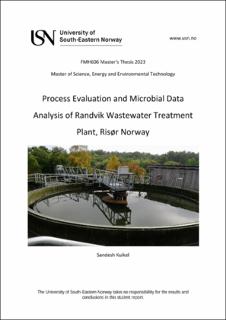Process evaluation and microbial data analysis of Randvik wastewater treatment plant, Risør Norway
Master thesis
Permanent lenke
https://hdl.handle.net/11250/3079007Utgivelsesdato
2023Metadata
Vis full innførselSamlinger
Sammendrag
The Randvik wastewater treatment plant at Risør, Norway is a biological wastewater treatment plant consisting of nitrification and denitrification processes both for organic and nutrient removal. The treatment plant is located at Risør municipality in Agder County Norway. The sewage treatment plant is the smallest of its kind, with an ultimate design capacity of 7000 PE (population equivalent). This study has investigated the process evaluation and microbial data analysis of the wastewater treatment plant. The physiochemical data collected over the last five years (2018-2022) was studied, and the correlation between microbial data (genomic sequencing data) obtained from polymerase chain reaction (PCR) techniques was attempted along with reviewing the literature to understand the results of the data analysis.
The physiochemical data analysis was based on secondary data which includes biochemical oxygen demand (BOD), total phosphorus(TP), total nitrogen(TN), and influent flow rate provided by the Risør municipality. The data analysis was performed by plotting and comparison on Microsoft Excel. A single-factor ANOVA test was performed in Excel to find out the significance of the data. The most prevalent microbial species in the Randvik wastewater treatment plant were identified using samples from the micro-biome sequencing results. The main results of the project were that the removal efficiency of the biological oxygen demand (BOD) and the total nitrogen (TN) was satisfied with the emission standards of the Norwegian legislative whereas the requirement for purification effect for total phosphorus (TP) concentration was nearly acceptable. The average treatment efficiency of organic pollutants for five years was found to be 98% while the total phosphorus removal efficiency was calculated as 88.42%. Likewise, the trend analysis between BOD and TP shows that it fluctuates at different times of the year and doesn't remain constant in both the influent and effluent wastewater.
The microbial profile of all the samples collected from the plant showed that the Actinomycetales, Saprospirales, Caldilineales, Acidimicrobiales, Rhizobiales, etc are the major microbial orders that dominate the wastewater. Further studies should focus on improving the conditions for phosphorus removal, which mean optimization of the anoxic/anaerobic tanks and reducing the sludge level in the settling tanks. Likewise, initiatives should be taken to reduce the sludge volume index of the treatment plant as it is quite higher (500-700 ml/g) out of the aerobic basin based on the treatment plant data. Based on recent investigations, this thesis also suggests a promising treatment method known as simultaneous nitrification-denitrification and phosphorus removal (SNDPR). Hence, the Randvik wastewater treatment plant can achieve an efficient SNDPR process with the current treatment plant setup.
